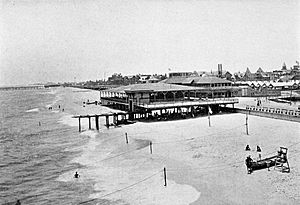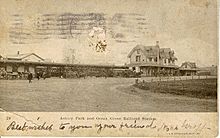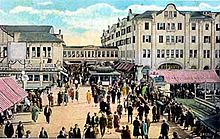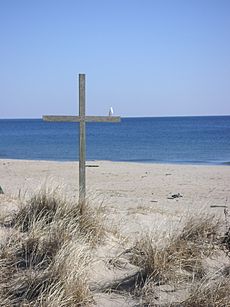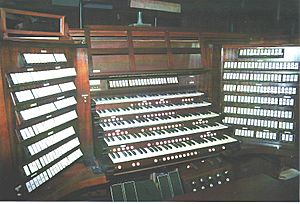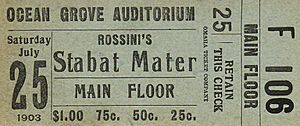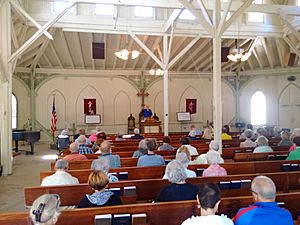Ocean Grove, New Jersey facts for kids
Quick facts for kids
Ocean Grove, New Jersey
|
|
|---|---|
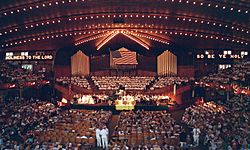
The Ocean Grove Great Auditorium (2007)
|
|
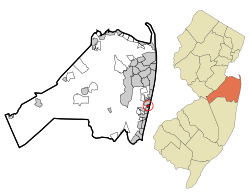
Location of Ocean Grove in Monmouth County, New Jersey. Inset: Location of Monmouth County in New Jersey.
|
|
| Country | |
| State | |
| County | Monmouth |
| Township | Neptune |
| Area | |
| • Total | 0.428 sq mi (1.109 km2) |
| • Land | 0.372 sq mi (0.964 km2) |
| • Water | 0.056 sq mi (0.145 km2) 13.05% |
| Elevation | 16 ft (5 m) |
| Population | |
| • Total | 3,342 |
| • Density | 8,979.9/sq mi (3,467.2/km2) |
| Time zone | UTC-5 (Eastern (EST)) |
| • Summer (DST) | UTC-4 (Eastern (EDT)) |
| ZIP code |
07756
|
| Area code(s) | 732 |
| FIPS code | 3454480 |
| GNIS feature ID | 02389609 |
Ocean Grove is a unincorporated community and census-designated place (CDP) located within Neptune Township, Monmouth County, New Jersey, United States. It had a population of 3,342 at the 2010 United States Census. It is located on the Atlantic Ocean's Jersey Shore, between Asbury Park to the north and Bradley Beach to the south. Listed on the National Register of Historic Places, Ocean Grove is noted for its abundant examples of Victorian architecture and the Great Auditorium, acclaimed as "the state’s most wondrous wooden structure, soaring and sweeping, alive with the sound of music".
Ocean Grove was founded in 1869 as an outgrowth of the camp meeting movement in the United States, when a group of Methodist clergymen, led by William B. Osborn and Ellwood H. Stokes, formed the Ocean Grove Camp Meeting Association to develop and operate a summer camp meeting site on the New Jersey seashore. By the early 20th century, the popular Christian meeting ground became known as the "Queen of Religious Resorts." The community's land is still owned by the camp meeting association and leased to individual homeowners and businesses. Ocean Grove remains the longest-active camp meeting site in the United States.
Contents
History
On July 31, 1869, Reverend W. B. Osborn, Reverend Stokes, and other Methodist ministers camped at a shaded, well-drained spot on New Jersey's seashore and decided to establish a permanent Christian camp meeting community called "Ocean Grove." About twenty tents were pitched that summer. By the following year paths were being graded, lots were sold, and plans were set in motion for a new town. In the summer of 1870, near the site of the first tabernacle, a well was dug to provide fresh water. It was named the "Beersheba" well, for an ancient well used by the Biblical patriarchs Abraham and Isaac, and is still in existence, though belatedly connected to the town water system in 1911.
Drawing from the major population centers of New York City and Philadelphia, Ocean Grove soon became a popular destination during the growth of the camp meeting movement in post-Civil War America. Tents and an open-air wooden shelter for speakers, were erected in the 1870s, for the trainloads of visitors arriving by the New York and Long Branch Railroad after 1875. In 1877 alone, 710,000 railroad tickets were sold for the Ocean Grove-Asbury Park train station.
A third, larger auditorium was built in 1880.
As Ocean Grove drew more and more visitors, the facilities were outgrown, and construction of the present Great Auditorium was completed in 1894. Originally designed to accommodate crowds of as many as 10,000 people, the subsequent installation of theater-style cushioned seating in many sections reduced seating capacity to 6,250. It remains Ocean Grove's most prominent structure and the centerpiece of its summer programs (see more about the Auditorium further down the page). By the early 20th century, said The New York Times in 1986, it was called the "Queen of Religious Resorts ... Visitors would travel miles to bask in the Victorian seaside splendor and to attend engaging, extroverted religious ceremonies. Millions of people, tourists and pilgrims both, made the trip to Ocean Grove every summer." The social disillusionment around 1920 following World War I had a profound effect on Ocean Grove and church going in general. There was a decline in interest in camp meeting type activities and there was little in the way of new construction in the town after this time. One result was that Ocean Grove became a time capsule of late Victorian and early 20th century architecture.
Until Ocean Grove's municipal authority was folded into Neptune Township in 1981, it had its own set of unique laws, including one that made it illegal on Sundays to have cars on the streets of Ocean Grove. This had a significant effect on the development of a close-knit community. People looking to get away for the weekend typically avoided the Grove (the beach was closed on Sunday, too). That meant the visitors were likely to be coming for a week-long visit or more. Most came to attend programs sponsored by the Camp Meeting.
President Ulysses S. Grant visited Ocean Grove during his time in office and made his last public appearance in this town. Other presidents to speak on the grounds included: James Garfield, William McKinley, Teddy Roosevelt, Woodrow Wilson, and Richard Nixon. Heavyweight boxing champions James J. Corbett and Max Baer and department store magnate F.W. Woolworth were among the celebrities of the day who vacationed in Ocean Grove.
In 1975, Ocean Grove was designated a State and National Historic District as a 19th-century planned urban community. It has the most extensive collection of Victorian and early-20th century architecture in the United States. The Historical Society of Ocean Grove maintains a museum and a restored c. 1884 cottage in addition to offering walking tours.
During the 1960s–1980s, the town declined along with much of the Jersey Shore, and was pejoratively called "Ocean Grave" due to the general air of decrepitude and the elderly population. But beginning in the 1990s, and through 2006, Ocean Grove experienced a dramatic increase in property values and a considerable revival in fortune, particularly with the restoration of older hotel structures, many of which had deteriorated into single room occupancy ("SRO") quarters. Also – as part of this resurgence – a number of sidewalk cafés and shops along Main Avenue (the main business thoroughfare) now cater to visitors and seasonal residents.
Plans were announced in 2006 for a major new hotel and condominium development on property which has been vacant since the 1970s, when the old North End Hotel – once Ocean Grove's largest – was damaged by fire and subsequently demolished in 1980. These plans have become controversial though, and in January 2008 the Planning Board of Neptune stated the North End Redevelopment Proposal was "inconsistent with the town's Master Plan". On 13 April 2019, the remaining structures on the North End were destroyed by fire leaving the whole area vacant land.
Geography
According to the United States Census Bureau, Ocean Grove had a total area of 0.428 square miles (1.109 km2), including 0.372 square miles (0.964 km2) of it is land and 0.056 square miles (0.145 km2) of water (13.05%) is water.
Demographics
| Historical population | |||
|---|---|---|---|
| Census | Pop. | %± | |
| 1880 | 620 | — | |
| 1890 | 2,754 | 344.2% | |
| 1990 | 4,818 | — | |
| 2000 | 4,256 | −11.7% | |
| 2010 | 3,342 | −21.5% | |
| Population sources: 1880-1890 1990–2010 2000 2010 |
|||
Because Ocean Grove is a summer resort community and many residences are unoccupied during the winter months, these statistics may not be representative of the population at all times of the year.
Census 2010
As of the census of 2010, there were 3,342 people, 1,948 households, and 616 families residing in the CDP. The population density was 8,979.9 per square mile (3,467.2/km2). There were 3,132 housing units at an average density of 8,415.6 per square mile (3,249.3/km2)*. The racial makeup of the CDP was 91.41% (3,055) White, 5.48% (183) Black or African American, 0.03% (1) Native American, 0.87% (29) Asian, 0.03% (1) Pacific Islander, 0.81% (27) from other races, and 1.38% (46) from two or more races. [[Hispanic (U.S. Census)|Hispanic or Latino of any race were 4.34% (145) of the population.
There were 1,948 households out of which 7.9% had children under the age of 18 living with them, 23.0% were married couples living together, 6.3% had a female householder with no husband present, and 68.4% were non-families. 57.2% of all households were made up of individuals, and 17.4% had someone living alone who was 65 years of age or older. The average household size was 1.64 and the average family size was 2.56.
In the CDP, the population was spread out with 8.1% under the age of 18, 4.8% from 18 to 24, 23.7% from 25 to 44, 38.9% from 45 to 64, and 24.5% who were 65 years of age or older. The median age was 52.7 years. For every 100 females there were 83.2 males. For every 100 females ages 18 and old there were 80.6 males.
Census 2000
As of the 2000 United States Census there were 4,256 people, 2,331 households, and 785 families residing in the CDP. The population density was 4,564.6/km2 (11,956.5/mi2). There were 3,156 housing units at an average density of 3,384.8/km2 (8,866.3/mi2). The racial makeup of the CDP was 93.1% White, 4.0% African American, 0.1% Native American, 1.0% Asian, <0.1% Pacific Islander, 0.9% from other races, and 0.9% from two or more races. Hispanic or Latino of any race were 3.6% of the population.
There were 2,331 households, out of which 10.0% had children under the age of 18 living with them, 23.6% were married couples living together, 7.7% had a female householder with no husband present, and 66.3% were non-families. 56.6% of all households were made up of individuals, and 14.5% had someone living alone who was 65 years of age or older. The average household size was 1.67 and the average family size was 2.59.
In the CDP the population was spread out, with 9.9% under the age of 18, 5.8% from 18 to 24, 33.5% from 25 to 44, 26.4% from 45 to 64, and 24.4% who were 65 years of age or older. The median age was 45 years. For every 100 females, there were 82.4 males. For every 100 females age 18 and over, there were 81.1 males.
The median income for a household in the CDP was $31,935, and the median income for a family was $58,583. Males had a median income of $38,389 versus $31,886 for females. The per capita income for the CDP was $26,232. About 5.1% of families and 13.3% of the population were below the poverty line, including 12.0% of those under age 18 and 5.5% of those age 65 or over.
Governance
The desire to develop a Christian seaside community for summer worship and relaxation led William B. Osborn (1832–1902), a leader of the camp meeting movement in mid-19th century America, to select the site of present-day Ocean Grove for its wooded, mosquito-free location. Ellwood H. Stokes (1815-1895), a Methodist minister from Philadelphia, and others joined to purchase a square mile of land fronting on the Atlantic Ocean. A state charter was issued to the newly formed Ocean Grove Camp Meeting Association on March 3, 1870, granting the 26 trustees (13 ministers and 13 lay persons) the authority to purchase and hold the one square mile of real estate comprising Ocean Grove, and to construct and maintain all necessary works to supply the community with utilities and other municipal services, including law enforcement.
Later, efforts to establish a separate borough of Ocean Grove were attempted many times. Ocean Grove was incorporated as a borough by an act of the New Jersey Legislature on April 5, 1920, from portions of Neptune Township, but the New Jersey Court of Errors and Appeals ruled the municipality unconstitutional on May 12, 1921, and the borough was dissolved as of June 16, 1921.
Although Ocean Grove reverted to being a part of Neptune Township with the court's decision of 1921, the Camp Meeting Association continued to exercise local ordinance enforcement powers until 1981, when a newspaper deliverer successfully sued to end the resort's blue law banning Sunday vehicular traffic and requiring it to disband its police force and "municipal" court. The Camp Meeting still owns all the land in town and leases it to homeowners and businesses for 99-year renewable terms. The Camp Meeting Association currently keeps its beach closed on Sunday mornings between 8:30 am and noon, and Ocean Grove is still "dry", that is, the sale of all alcoholic beverages is prohibited.
The Great Auditorium
The Great Auditorium was constructed in 1894 and is mostly unchanged. The wooden building rests on bridge-like steel trusses laid on stone foundations. Aside from the trusses. It features numerous "barn door" entrances with colored glass, dormers, and panels that open for ventilation. Originally, the Auditorium was claimed to hold an audience of almost 10,000. Many of smaller, wooden seats were replaced in later years with cushioned, theater-style seating reducing capacity to an audience of 6,250 persons.
The Auditorium has been called, "the state’s most wondrous wooden structure, soaring and sweeping, alive with the sound of music". Its superb acoustics, resulting from its barrel-vaulted wooden ceiling, have been widely acclaimed; famed conductor Leonard Bernstein once compared it to Carnegie Hall. In the days before electronic amplification, this allowed a preacher to be heard throughout the vast space. The building features a lighting system advanced for its time: arching rows of bulbs hanging from the varnished wood ceiling paneling. Also novel is a painted representation of a waving American flag (c. 1916) covered with light bulbs that flash in an undulating manner. Illuminated signs, possibly the very oldest surviving examples of that type (1894), proclaim "Holiness to the Lord" and "So be ye holy," a reflection of the emphasis at camp meetings. The illuminated Memorial Cross was placed on the Auditorium's front facade at the end of World War II in 1946.
The hall is surrounded by 114 tents, which are occupied from May to September, as has been the case since 1869. Each tent is connected to a shed containing a kitchen and bathroom; the sheds are also used to store the tents during the winter. They are in such demand that there is a waiting list of some ten years for summer rentals.
Organ
The Auditorium's pipe organ is one of the 20 largest in the world. Installed in 1908 by the organ builder Robert Hope-Jones, its components have been rebuilt and expanded several times, especially since resident organist Gordon Turk and curator John Shaw (who died on July 24, 2019) took their posts in 1974 and 1975, respectively. Additions made in the 21st century include a 14-rank echo division in 2008, in an effort to broaden the resources necessary to play repertoire of many styles and periods, and to restore those stops unique to the instrument as Hope-Jones conceived it. In the 2010s, the organ continues to be further enlarged and revoiced, with additions underwritten by donors. As of July, 2018, the organ has five manuals, 202 ranks, and 12,200 total pipes. About 75 percent of the original Hope-Jones pipework remains extant, according to John Shaw.
Prominent organists to have played the Ocean Grove Auditorium organ include Edwin H. Lemare, Pietro Yon, and Frederick Swann. Celebrated organist Virgil Fox gave his last solo concert in the building in 1980. Turk and guest concert organists play free recitals on most Wednesday evenings and Saturday afternoons in July and August.
A popular organ piece, often played in the early years of the organ, was "The Storm", which featured the stops of the organ for thunder, lightning, rain, and birds singing. An article in the New York Times from 1909 reports on the annoyance of some at the frequent repetition of the performances of the piece.
Performances and other events
The Great Auditorium has over the years featured famed hymn writer Fanny Crosby, band leader John Philip Sousa, and tenor Enrico Caruso. More recently, singers Tony Bennett, Mel Tormé, Kenny Rogers, and Ray Charles have performed there.
The Auditorium continues to be the focus of cultural life in Ocean Grove. Among the concerts filling the summer schedule are the acclaimed Summer Stars chamber music programs, which bring some of the finest classical musicians from Philadelphia and New York each Thursday night in July and early August. Saturday nights feature popular entertainment, including appearances by Johnny Mathis, Ronan Tynan, Linda Eder, the Beach Boys, comedian Bill Cosby, and Christian rock stars such as Michael W. Smith, Steven Curtis Chapman, Nichole Nordeman, Hillsong United l, and Sonic Flood.
Since 1980, the Auditorium has hosted an annual memorial service for New Jersey law enforcement officers killed in the line of duty. The service includes a full Honor Guard, bagpipe procession, and singing by state high school choirs (Princeton High School and both West Windsor-Plainsboro High School choirs have performed in the past). Police, soldiers, National Guardsmen, executive-level officials, and the governor typically attend.
The Auditorium is also used during the month of June for high school graduation ceremonies.
Ocean Grove Camp Meeting Association
The OGCMA was founded in 1869. Its mission is to "provide opportunities for spiritual birth, growth, and renewal in a Christian seaside setting."
The OGCMA's president is Dr. Dale C. Whilden. He succeeded political analyst Scott Rasmussen, who was president from 2006 to 2011. The OGCMA's slogan is "God's Square Mile at the Jersey Shore."
Tent City
From May to September of each year, 114 tents are erected around the Great Auditorium. These tents form "Tent City," a tradition of the Camp Meeting Association that dates back to 1869. Each tent is connected to a shed containing a kitchen and bathroom; the sheds are also used to store the tents during the winter. Tents are in such demand that there is a waiting list of over ten years for summer rentals. Rent runs from $4,000 to $6,000 per summer. All prospective tent inhabitants are interviewed. Subletting of tents is not allowed; dogs, cats, and barbecuing are also prohibited. Tent inhabitants do not have to be Methodist, but they do have to support the association's spiritual missions.
Programs
The Camp Meeting offers traditional and contemporary worship programs throughout the summer. Sunday worship services are held in the Great Auditorium. These services have featured preachers such as Billy Graham, Norman Vincent Peale, Robert H. Schuller, Billy Sunday, Ralph W. Sockman, David H. C. Read, Frank Thewlis, Tony Campolo, James A. Forbes, D. James Kennedy, Charles Stanley, William Jennings Bryan, Booker T. Washington, and Rodney "Gipsy" Smith.
The music is led by a volunteer choir, along with professional soloists such as Ronald Naldi. Gordon Turk accompanies at the Hope-Jones organ. Jason C. Tramm is the musical director. Lewis A. Daniels Sr. (1927–2012), was director of music from 1966 to 2004. Since 1955, the annual Choir Festival held in July has gathered thousands of church choir singers, predominantly from the northeastern U.S., to sing "to the glory of God". In 1986, New York television station WNET featured the Choir Festival on its Summerfare program. The Choir Festival is also a regular feature on the Sacred Classics radio broadcast.
The Camp Meeting also offers a contemporary worship service, "Pavilion Praise," in the beach's Boardwalk Pavilion each Sunday morning. A Bible Hour is held each weekday morning in the Bishop Janes Tabernacle, built in 1877, adjacent to the Great Auditorium.
"Bridgefest," an annual two-day event, brings contemporary Christian music to young people and their families. The event is promoted by New York–area radio station "Bridge FM" (WRDR-FM).
Hurricane Sandy
In 2012, Hurricane Sandy caused extensive damage in Ocean Grove. Over half of the town's boardwalk was destroyed, and the town's fishing pier was significantly damaged. Ocean Grove was denied Federal Emergency Management Agency funding because the Camp Meeting Association is a nonprofit organization. While nonprofit organizations are eligible to receive FEMA funding, Ocean Grove was denied funding because the boardwalk was classified as being used solely for recreational purposes. The town formed a group called "Together" to address storm recovery. The group includes the Camp Meeting Association, the chamber of commerce, the homeowners association, the beautification committee, the historic society, the fishing club, and Ocean Grove United, a gay and lesbian group.
Hurricane repairs are estimated to cost $3.5 million. The "Together" campaign raised $1.5 million, including $750,000 for the boardwalk, $100,000 for the roof of the Great Auditorium, and $500,000 for architectural and structural repairs to Thornley Chapel. The Camp Meeting Association has appealed FEMA's funding rejection three times. Federal officials also denied the Camp Meeting Association's request for funding in the wake of Hurricane Irene.
In 2013, members of the gay-rights group Ocean Grove United and the OGCMA joined up to co-sponsor an event aimed at raising funds to rebuild Ocean Grove's hurricane-damaged boardwalk.
The third appeal by OGCMA to FEMA, supported by some NJ politicians, was accepted. As MaryAnn Spoto elucidated on NJ.com 7/3/14: "Sandy destroyed about a third of Ocean Grove's nearly half-mile of boardwalk....FEMA's $2.3 million to Ocean Grove includes $1.13 million for that project as well as money for three other recovery projects."
Gay relations
From the late 1990s through 2000s, Ocean Grove saw the opening of a large number of gay-owned restaurants, hotels, and stores. According to the New York Times, Ocean Grove's gay and Methodist populations coexisted peacefully until a 2007 controversy over whether gay couples could conduct civil unions at the Camp Meeting Association's Boardwalk Pavilion. Previously, the Association sought to realize income from its structures by renting them as wedding venues. There were no religious restrictions placed on the ceremonies. Also according to The New York Times, "Ocean Grove has long been considered a community that embraced gay residents." In 2007, a representative of Garden State Equality, a LGBT rights advocacy organization, said: "I'm hearing from gay people all over the country who thought Ocean Grove was the leading light for gay tolerance and that's not the case anymore."
In 2012, Christian actor Kirk Cameron gave a lecture in Ocean Grove on the subject of strengthening marriage. Cameron's lecture sparked a protest by gay rights activists. After Cameron's speech, a lunch was arranged between members of the Camp Meeting Association and members of the gay community. Camp Meeting Association President Dale Whilden said, "This is an opportunity to show that we respect them." Democratic congressman Frank Pallone attended the event. Steven Goldstein of Garden State Equality, noted: "We may not agree on everything, but we are, today, starting to see each other as human beings."
In 2013, the Human Rights Campaign, a LGBT rights advocacy group, included Ocean Grove in its Municipal Equality Index, a study that scores 291 American cities based on their inclusivity of LGBT people. Ocean Grove scored 77 out of 100, representing the second highest score for cities located in New Jersey.
Transportation
Roads and highways
Interstate 195 provides highway access to Ocean Grove from the New Jersey Turnpike, Philadelphia, and points west. The nearby Garden State Parkway connects Ocean Grove with points north and south, such as New York City and Atlantic City.
Public transportation
Frequent rail passenger service to New York City is provided by NJ Transit on the North Jersey Coast Line from the nearby Asbury Park station. New Jersey Transit offers service between Ocean Grove and Philadelphia on the 317 route and local bus service on the 830 route. Additionally, Academy Bus has regular service to area shore towns and the Port Authority Bus Terminal in Midtown Manhattan.
The nearest airport having scheduled commercial airline service is Newark Liberty International Airport, 45 miles (72 km) north, while Monmouth Executive Airport for general aviation airplanes is just 6 miles (10 km) away.
Climate
According to the Köppen climate classification system, Ocean Grove has a humid subtropical climate (Cfa). Cfa climates are characterized by all months having an average temperature > 32.0 °F (0.0 °C), at least four months with an average temperature ≥ 50.0 °F (10.0 °C), at least one month with an average temperature ≥ 71.6 °F (22.0 °C) and no significant precipitation difference between seasons. Although most summer days are slightly humid with a cooling afternoon sea breeze in Ocean Grove, episodes of heat and high humidity can occur with heat index values > 103 °F (39 °C). Since 1981, the highest air temperature was 100.3 °F (37.9 °C) on August 9, 2001, and the highest daily average mean dew point was 77.4 °F (25.2 °C) on August 13, 2016. The average wettest month is July which correlates with the peak in thunderstorm activity. Since 1981, the wettest calendar day was 5.56 inches (141 mm) on August 27, 2011. During the winter months, the average annual extreme minimum air temperature is 3.8 °F (−15.7 °C). Since 1981, the coldest air temperature was −5.7 °F (−20.9 °C) on January 22, 1984. Episodes of extreme cold and wind can occur with wind chill values < −6 °F (−21 °C). The average seasonal (Nov-Apr) snowfall total is between 18 inches (46 cm) and 24 inches (61 cm), and the average snowiest month is February which corresponds with the annual peak in nor'easter activity.
| Climate data for Ocean Grove, 1981-2010 normals, extremes 1981-2019 | |||||||||||||
|---|---|---|---|---|---|---|---|---|---|---|---|---|---|
| Month | Jan | Feb | Mar | Apr | May | Jun | Jul | Aug | Sep | Oct | Nov | Dec | Year |
| Record high °F (°C) | 71.6 (22.0) |
78.8 (26.0) |
82.1 (27.8) |
88.8 (31.6) |
94.9 (34.9) |
96.8 (36.0) |
99.8 (37.7) |
100.3 (37.9) |
97.5 (36.4) |
93.9 (34.4) |
80.7 (27.1) |
75.0 (23.9) |
100.3 (37.9) |
| Average high °F (°C) | 40.1 (4.5) |
42.7 (5.9) |
49.2 (9.6) |
58.7 (14.8) |
68.2 (20.1) |
77.5 (25.3) |
82.8 (28.2) |
81.7 (27.6) |
75.5 (24.2) |
65.1 (18.4) |
55.3 (12.9) |
45.2 (7.3) |
61.9 (16.6) |
| Daily mean °F (°C) | 32.4 (0.2) |
34.8 (1.6) |
40.9 (4.9) |
50.3 (10.2) |
59.9 (15.5) |
69.4 (20.8) |
74.9 (23.8) |
73.9 (23.3) |
67.3 (19.6) |
56.4 (13.6) |
47.3 (8.5) |
37.7 (3.2) |
53.9 (12.2) |
| Average low °F (°C) | 24.8 (−4.0) |
26.8 (−2.9) |
32.7 (0.4) |
41.9 (5.5) |
51.5 (10.8) |
61.2 (16.2) |
67.0 (19.4) |
66.0 (18.9) |
59.1 (15.1) |
47.6 (8.7) |
39.2 (4.0) |
30.1 (−1.1) |
45.7 (7.6) |
| Record low °F (°C) | −5.7 (−20.9) |
1.0 (−17.2) |
6.0 (−14.4) |
18.3 (−7.6) |
35.4 (1.9) |
44.8 (7.1) |
48.9 (9.4) |
45.5 (7.5) |
39.5 (4.2) |
26.7 (−2.9) |
15.1 (−9.4) |
−0.2 (−17.9) |
−5.7 (−20.9) |
| Average precipitation inches (mm) | 3.62 (92) |
3.07 (78) |
3.97 (101) |
4.12 (105) |
3.75 (95) |
3.61 (92) |
4.70 (119) |
4.66 (118) |
3.59 (91) |
3.90 (99) |
3.88 (99) |
4.02 (102) |
46.89 (1,191) |
| Average relative humidity (%) | 64.6 | 61.7 | 60.3 | 61.8 | 65.7 | 70.0 | 69.6 | 71.2 | 71.3 | 69.4 | 67.3 | 65.3 | 66.5 |
| Average dew point °F (°C) | 21.8 (−5.7) |
23.0 (−5.0) |
28.2 (−2.1) |
37.7 (3.2) |
48.4 (9.1) |
59.2 (15.1) |
64.3 (17.9) |
64.0 (17.8) |
57.7 (14.3) |
46.5 (8.1) |
37.0 (2.8) |
27.1 (−2.7) |
43.0 (6.1) |
| Source: PRISM | |||||||||||||
| Climate data for Sandy Hook, NJ Ocean Water Temperature (18 N Ocean Grove) | |||||||||||||
|---|---|---|---|---|---|---|---|---|---|---|---|---|---|
| Month | Jan | Feb | Mar | Apr | May | Jun | Jul | Aug | Sep | Oct | Nov | Dec | Year |
| Daily mean °F (°C) | 37 (3) |
36 (2) |
40 (4) |
46 (8) |
55 (13) |
62 (17) |
69 (21) |
72 (22) |
68 (20) |
59 (15) |
51 (11) |
43 (6) |
53 (12) |
| Source: NOAA | |||||||||||||
Ecology
According to the A. W. Kuchler U.S. potential natural vegetation types, Ocean Grove would have a dominant vegetation type of Appalachian Oak (104) with a dominant vegetation form of Eastern Hardwood Forest (25). The plant hardiness zone is 7a with an average annual extreme minimum air temperature of 3.8 °F (−15.7 °C). The average date of first spring leaf-out is March 24 and fall color typically peaks in early-November.
Notable people
People who were born in, residents of, or otherwise closely associated with Ocean Grove include:
- Mary Porter Beegle (c. 1881–1966), dancer, theater professional and college administrator.
- Perdita Buchan (born 1940), author
- Thomas Chisholm (1866–1960), Christian songwriter who wrote Great Is Thy Faithfulness.
- Michelle Davidson (born 1970), English Channel swimmer and U.S. Master Swimmer All-American.
- Southside Johnny (born 1948 as John Lyon), singer songwriter.
- Tali Esen Morgan (1858-1941), longtime music director at Ocean Grove
- Shep Pettibone (born 1959), record producer, remixer, songwriter and club DJ, who was most prolific in the 1980s.
- Haydn Proctor (1903–1996), member of the New Jersey Senate.
- Scott Rasmussen (born 1956), co-founder of ESPN and political analyst.
- George A. Sheehan (1918–1993), cardiologist and running advocate.
- David Spelman (born 1966), curator and music producer.
- Richard R. Stout (1912–1986), politician who served in the New Jersey Senate from 1952 to 1974.
- Ronald R. Thomas (born 1949), writer, educator, and 13th president of the University of Puget Sound.
See also
 In Spanish: Ocean Grove (Nueva Jersey) para niños
In Spanish: Ocean Grove (Nueva Jersey) para niños


